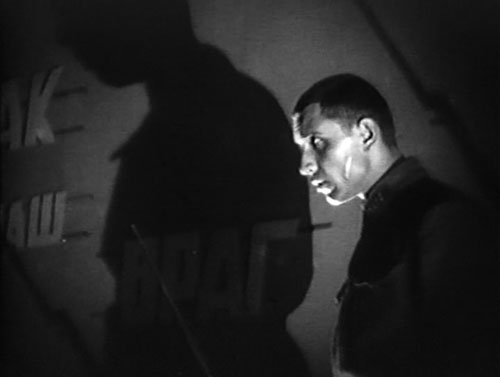Mikhail Kalatozov’s career had a large hole in the middle, one that remains incompletely explained. Why were the two periods of his greatest work separated by roughly three decades? Why did he make almost nothing between? The answer definitely involved Stalin and his fickle cultural watchdogs, even if the full reason for such a long lull (or fall from favor) might never be known.
At least he was spared a permanent gulag vacation, which would have deprived us of a late 1950s reflowering that resulted in three world classics still being discovered in the West — particularly since 1964’s astonishing I Am Cuba got rereleased under Francis Ford Coppola and Martin Scorsese’s auspices 16 years ago. If you’ve seen that or another Kalatozov film, it’s distressing to think he spent any time unwillingly idle, since every feature still accessible today is some kind of masterpiece.
The San Francisco Silent Film Festival’s 16th annual edition offers the last feature he made before that mysterious long withdrawal from the director’s chair. Nail in the Boot (1931) lasts just 53 minutes, but packs in more photographic and editorial ideas than a dozen features twice its length. It’s a dazzling application of sheer stylistic invention to propagandic material. Yet rather than please the apparatchiks upstairs, it ticked them off enough to derail Kalatozov’s career for a good spell.
Born in Tbilisi, Georgia, he began working as an actor, editor, and cinematographer in that (reluctant) Soviet republic’s 1920s film industry, eventually graduating to directing documentaries celebrating the USSR’s industrial, agricultural, and cultural advancement. Little is known about a first narrative feature, 1930’s Little Blind Girl. But the same year’s semi-staged Salt for Svanetia won acclaim for its strikingly poetical imagery of life in a remote Caucasus Mountains village.
That success presumably greased the way for the larger endeavor of Nail in the Boot, which mixes up the epic and the intimate, beautiful shots of lovingly lit machinery and glowing worker faces intercut with striking battle vistas and the proverbial cast of thousands. The story can be reduced to the title’s troublesome metal inch: when enemy forces strand armored train “Guardian of the Revolution” between blown-up track sections, a lone comrade (Aleqsandre Jaliashevili) is dispatched on foot to notify HQ. Running over hill and dale, he’s severely hampered when the poorly made boot from his own factory falls apart, driving a binding nail into his foot. As a result, his trapped compatriots are gassed to death before reinforcements arrive.
At a huge subsequent Party trial, our fallen hero is excoriated as a traitor for stopping to soak his painful, bleeding foot. “You shot them! The undelivered dispatch was like a bullet!” “He spared his feet and destroyed the armored train!” angry comrades shout, calling for his head. But this nameless prole finally defends himself, indicting his footwear’s shoddy workmanship as at least equal in fault. Nail in the Boot was intended as a parable (based in turn on a Russian folk tale) urging Soviets to always perform superlatively for the good of all, whatever their job. A final intertitle accuses lazy bones present: “Among you spectators: are there many like the bootmakers?”
That message seems simple and unimpeachable enough, not to mention spectacularly presented. Yet Nail had the ill fortune to arrive just as USSR arts ideology was changing. The experimentation encouraged in the 1920s was now judged indulgent “formalism” unsuitable for the masses, while a new school of nail-on-the-head “Social Realism” took shape as the sole officially state-sanctioned artistic guideline. Kalatozov’s film was denounced as confusing and unrealistic on petty grounds, as well being guilty of “formalistic aestheticism.” The film was banned, for a long time considered lost, and beyond a couple features at the start of World War II, Kalatozov was kept offscreen — albeit kicked upstairs to various film administrative posts.
He did well enough in those capacities to become the Soviet film industry’s emissary to Hollywood for an extended late 1940s stay. Hobnobbing with stars, he greatly admired the major studios’ streamlined production methods and technical advances — but like a good comrade, returned home to condemn Tinsel Town as the apex of capitalist decadence. (Hell yeah!) Then, finally, he was considered rehabilitated enough to trust behind a camera once again.
The results, after a few more conventional features no longer in circulation, were stupendous: 1957’s The Cranes Are Flying introduced a new Kalatozov, energetic and inventive as ever, director of photography Sergei Urusevsky’s wildly mobile camera replacing rhythmic Eisensteinian montage as his primary instrument. Taken as a cinematic emblem of Khrushchev-era Cold War thawing, it was an international triumph, even if its tragic wartime romance now seems less conceptually unique than two extraordinary (if far less popular) next ventures.
The Unsent Letter (1960) is one of the movies’ great man vs. nature depictions, as Soviet geologists searching for diamond deposits in remotest Siberia fall prey to that land’s geographic and climatic extremes. I Am Cuba, a Soviet-Cuban collaboration depicting the Cuban revolution on a humongous scale, was derided as being “too Russian” by the Cubanos, “too formalist” (or whatever the current ideological phrase was) by Moscow. Forgotten for decades, it’s been much written about lately — suffice to say Roger Ebert thought it contained the single “most astonishing [shot] I have ever seen,” amid 141 minutes full of such wonders.
After less idiosyncratic but impressive 1970 Soviet-European superproduction The Red Tent (1970) — an arctic adventure with international stars like Sean Connery and Claudia Cardinale, shot in locations as frigid as 40 below zero — Kalatozov died at age 70, planning another impossibly ambitious epic. In a perfect world, he’d actually finish it, his cryogenically frozen brain retrieved from some secret polar lab. Imagine what he could do with a Steadicam and 3-D; James Cameron might find himself merely a wee prince of the world by comparison.
SAN FRANCISCO SILENT FILM FESTIVAL
Thurs/14–Sun/17, free–$20
Castro Theatre
429 Castro, SF
(415) 621-6120

